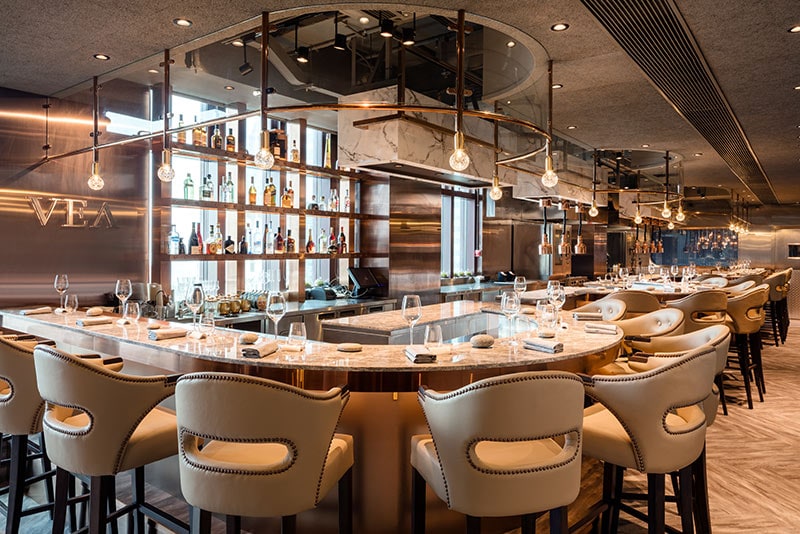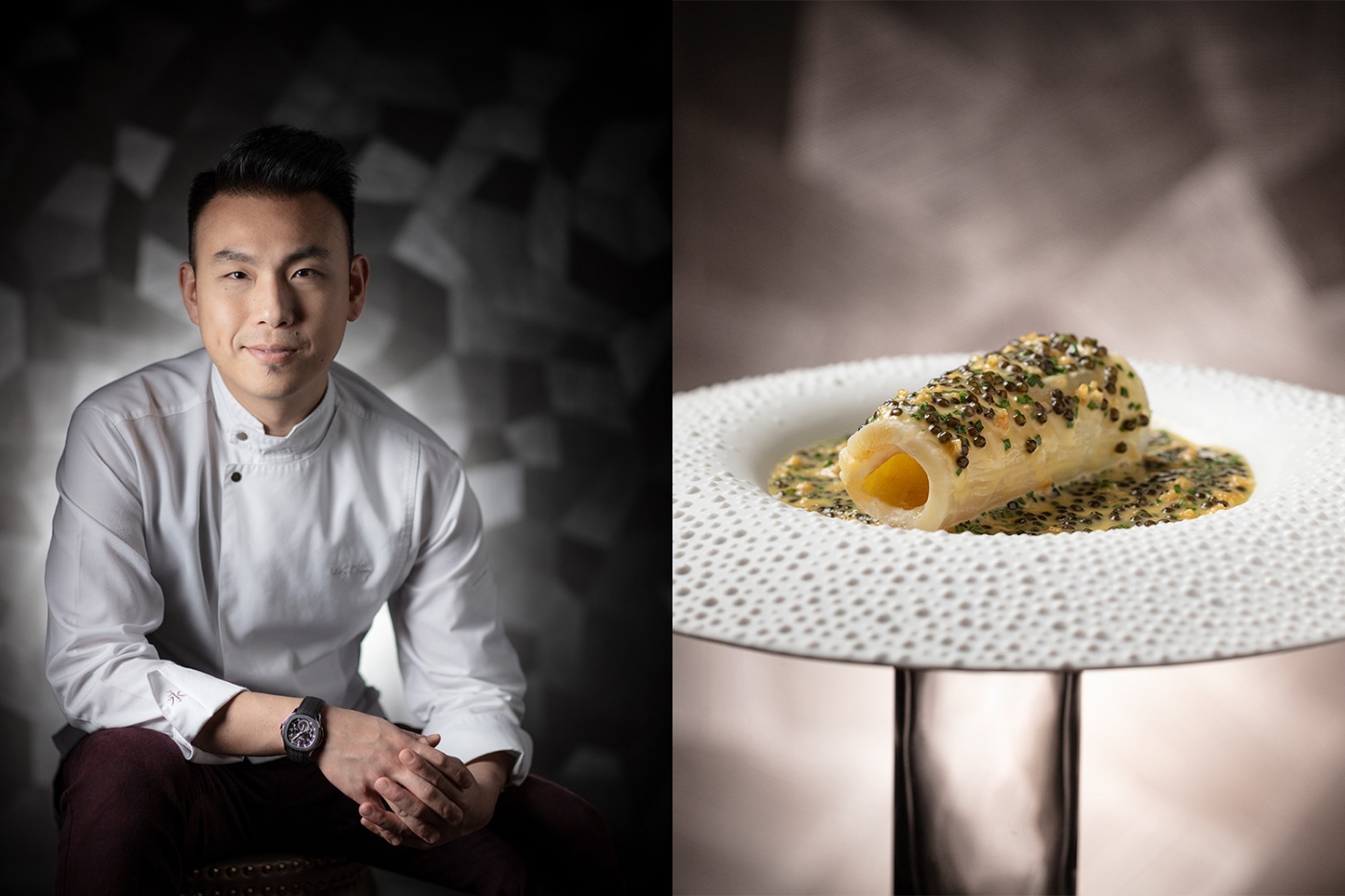The Real Diet of 1-Michelin Star Chef Vicky Cheng
Chef Vicky Cheng of one-Michelin-star VEA in Hong Kong, a forerunner of Chinese-French cuisine, cradles a plump coconut conch with a gleaming Patek Philippe slapped on his wrist. Precision and timing are very important in the kitchen, since the stakes are high when it comes to a fusion-driven approach. But looking the part does have its merits, too (with the Chinese crowd).
My first encounter with chef Vicky was on a Korean trip to uncover the intricacies of banchan. When we were visiting the traditional market, he beamed with innocent youth as he exchanged knowledge with the vendor before purchasing a large amount of dried acorn jelly. I could sense the cogs turning inside his head as to what he would create. Curious to uncover more of his personality, I caught up with chef Vicky (when he was in town for a 4-hands dinner with Julien Royer of Odette) to talk about his daily rituals, guilty pleasures and secret suppers at VEA.

High Net Worth: At VEA, you focus on marrying modern French techniques and Chinese ingredients. Does the inspiration usually start with a certain Chinese ingredient, a food memory or a play on a French classic dish?
Vicky Cheng: Usually, the inspiration may come from many different sources. Sometimes it’s through finding a very specific and inspiring ingredient in the market. Sometimes it is my curiosity towards dried seafood, mainly in the form of dried abalone, sea cucumber or fish maw that sparks creativity. With any new endeavour, I usually try to start off with a high-interest level—the chances of success are much higher as you’re naturally drawn to achieve something with it.
There are also occasions when I try to re-interpret classic dishes. Here and there, I would recall dishes that I grew up eating and I try to recreate that memory. Then, there are those traditional heritage dishes with oddball combinations that I’ve never heard of. But at VEA, we always try to make the end product unique, and in the process, build our own character.
Take us through a typical day for you.
When I’m in Hong Kong, I prefer dedicating most of my time to be at the restaurant. In the mornings, I will go to the market to shop for the restaurant. I have a special relationship with most of my suppliers whereby if they chance upon something interesting or one-off, they would usually ring me up and keep some aside for me. At home, I would usually experiment with my market finds. Cooking lunch for my wife and child is one of life’s greatest pleasures and I particularly enjoy discovering new cooking methods in the comfort of my own kitchen. After lunch, I would take the rest of my loot with me and head back to the restaurant.
What do you eat for lunch?
I secretly enjoy noodles. So if I’m not indulging in seafood that I’ve brought back from the market with my wife and daughter, I’m usually enjoying a simple meal of noodles. Thai, Vietnamese or Chinese, they all float my boat. I often say this: I harbour hopes of opening a noodle shop one day.
How does supper usually roll for you and the kitchen crew?
Supper is at 4:30pm sharp. We will a cook staff meal for everyone and that’s the only time of day the restaurant ‘family’ gets to sit down and enjoy a meal together.
Are late-night eats a thing for most chefs or do you just sleep off the hunger?
I never believe in sleeping off the hunger. In fact, there’s a saying that goes, “One should never go to bed hungry.” Of course, I try to be responsible by avoiding a heavy meal after service, but there’s the occasional late-night rendezvous with friends or colleagues that lead me astray. Having excessive carbs before bed is definitely not good, and I usually counter the temptation with a bowl of salad. That being said, most of the time I satiate my hunger with a humble bowl of noodles.

If supper is on the agenda, where are some of the places you’ll hit up in Hong Kong?
Supper at VEA is a big thing! It’s funny because it accidentally started as more of a small group affair. Eventually, it became so popular with family and friends because I was behind the stove. In all honesty, I usually don’t cook in my own restaurant, as I have to train my staff to ensure they are sufficiently skilled to run the kitchen even in my absence. However, come supper time, I’m actually the one cooking at VEA and I genuinely enjoy it. It has become quite a popular meal for friends who love to dine. Otherwise, it’s just street food that’s cooked at home: vegetables and rice. I’m simple like that.
On your day off, do you cook for your family at home?
Yes, I love cooking for my wife, daughter and myself, even on a day off—preferably accompanied by a bottle of wine.
What is your guilty pleasure?
I’m crazy about fried food. I love to eat crispy potato chips and french fries. I also enjoy Shin Ramyun (Korean instant noodles). Do you know the most famous one in a red packet?
What’s your drink of choice?
My preference lies with wine and champagne more. But in terms of cocktails, I do appreciate a classic negroni, old fashioned or the occasional martini.
We notice that you visit fellow chef friends’ restaurants when travelling overseas. Any favourites in particular and do you have a go-to list?
Recently, I had a chance to dine at Mingles when I was in Korea and it was a great meal. Another outstanding restaurant is Mosu, and they’re making waves in a short period of time. As a chef, sometimes it’s about making the extra effort to see your friends and meet new ones; that way you can really broaden your spectrum. For chefs and restaurateurs, it can be extremely hard at times because creating new dishes and running our restaurant always take priority.


